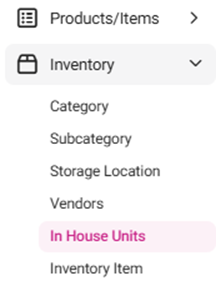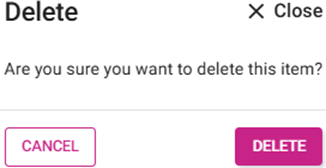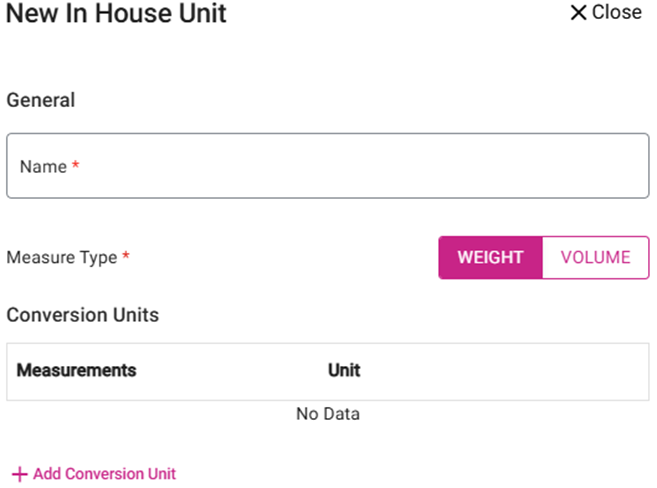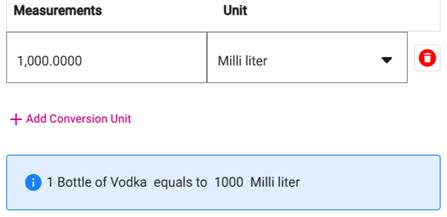Back Office: In-House Unit Inventory
Sign into the Back Office and select a Store.
On the left-side Navigation Panel, click Inventory then In House Units.

The In House Units page appears, including a table containing the following columns:
Name - The name of the Inhouse Units will be displayed.
Measure Type - The user can select measurement type either Volume Or Weight.
Actions - In this column the Edit and Delete buttons appear.
Delete – The Delete pop-up including the message ‘Are you sure you want to delete this item’ appears, with Cancel and Delete options.

Select Delete and the In House Unit is sent to Inactive status with a ‘In House Unit inactivated successfully’ confirmation message appearing.
Select Cancel, and the In House Unit is kept in Active status.
Create an In House Unit (or Edit an existing In House Unit
- Click the pink + New In House Unit button at the top-right (or click the corresponding Edit [pencil] of an existing In House Unit).

The New In House Unit (or Update In House Unit) pane appears.

- The Save / Update button is disabled by default - and will be enabled only after filling in all mandatory fields (and for updating a In House Unit, updating an existing field).
- Name – (Mandatory) Enter the Name of the In House Unit. Maximum of 25 characters.

Measure Type – (Mandatory) Select either Weight or Volume via the toggle.

Conversion Units – Contains a table with columns for Measurements and Unit.
- Select + Add Conversion Unit to create a new row.
- Enter the Measurement of the Conversion Unit (up to 4 decimal places).

- Select the Unit from the dropdown (you can Search to identify the Unit more quickly). A light blue banner appears below, based on the values entered.
Format: 1 [Name] equal to [Measurements] [Unit]
- Example 1: You buy a 5kg potato bag but when you make a Menu Item you use potatoes in grams, then you need to make a Unit conversion from kg to grams. So, it would be 1 bag of potatoes (5kg) = 5000 grams.

- Example 2: You buy a bottle of Vodka (1 Liter) but when we make drinks, we use Vodka in ml. So, you convert 1L bottle into 1000 ml.

Select Save to create the new In House Unit (or Update to update an existing In House Unit). You’re returned to the In House Unit page and a confirmation message appears at the top-right.
- Click Cancel / X Close to close the pane without creating or updating the In House Unit.

Related Articles
Back Office: Inventory Items
Sign into the Back Office. On the left-side Navigation Panel, click Inventory then Inventory Item. The Inventory Item page appears, with tabs for Inventory Items and Retail Items – along with a Select Categories dropdown and a Total Value On Hand. ...
Back Office: Inventory Sub Recipe
Sign into the Back Office then select a Store. On the left-side Navigation Panel, click Inventory then Sub Recipe. The Sub Recipe page appears, which displays a table containing a list of Sub Recipes that have already been created. If you are ...
Back Office: Home
Sign into the Back Office. then select a Store. You should be taken to that store’s Home page. If not, then on the left side navigation, click Home. Tip: Type the name of the Store in the Search bar for quicker Store selection. For every Dashboard ...
Back Office: Enterprise - Central Kitchen
Sign into the Back Office. On the left-side Navigation Panel, click Enterprise. On the Enterprise page, click Central Inventory then select Central Kitchen. The main Central Kitchen page contains tiles of existing kitchen - with a Search option, a ...
Back Office: Adjust Inventory
Sign into the Back Office. On the left-side Navigation Panel, click Inventory then Adjust Inventory. The Adjust Inventory screen appears, with tabs for Inventory Item, Retail Item and Sub-Recipe. At the upper-right portion of each tab’s page, buttons ...